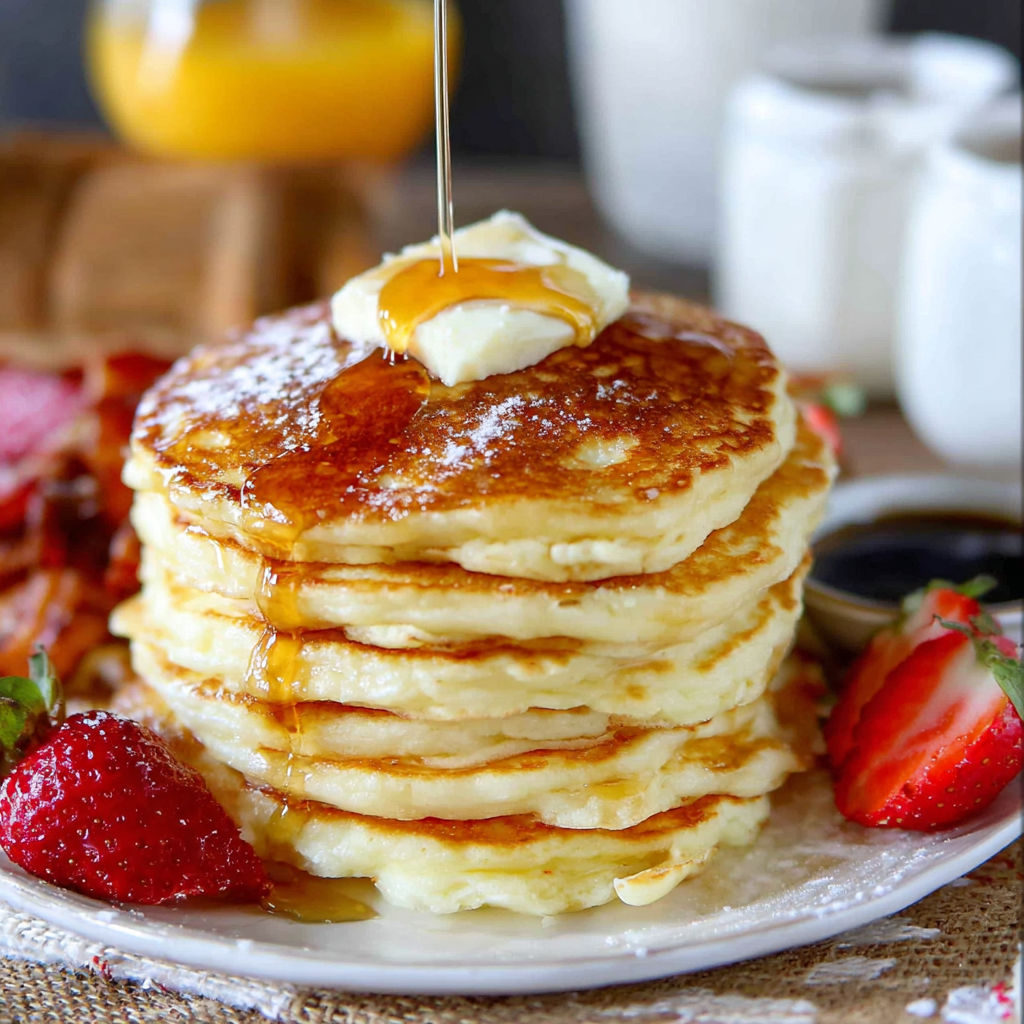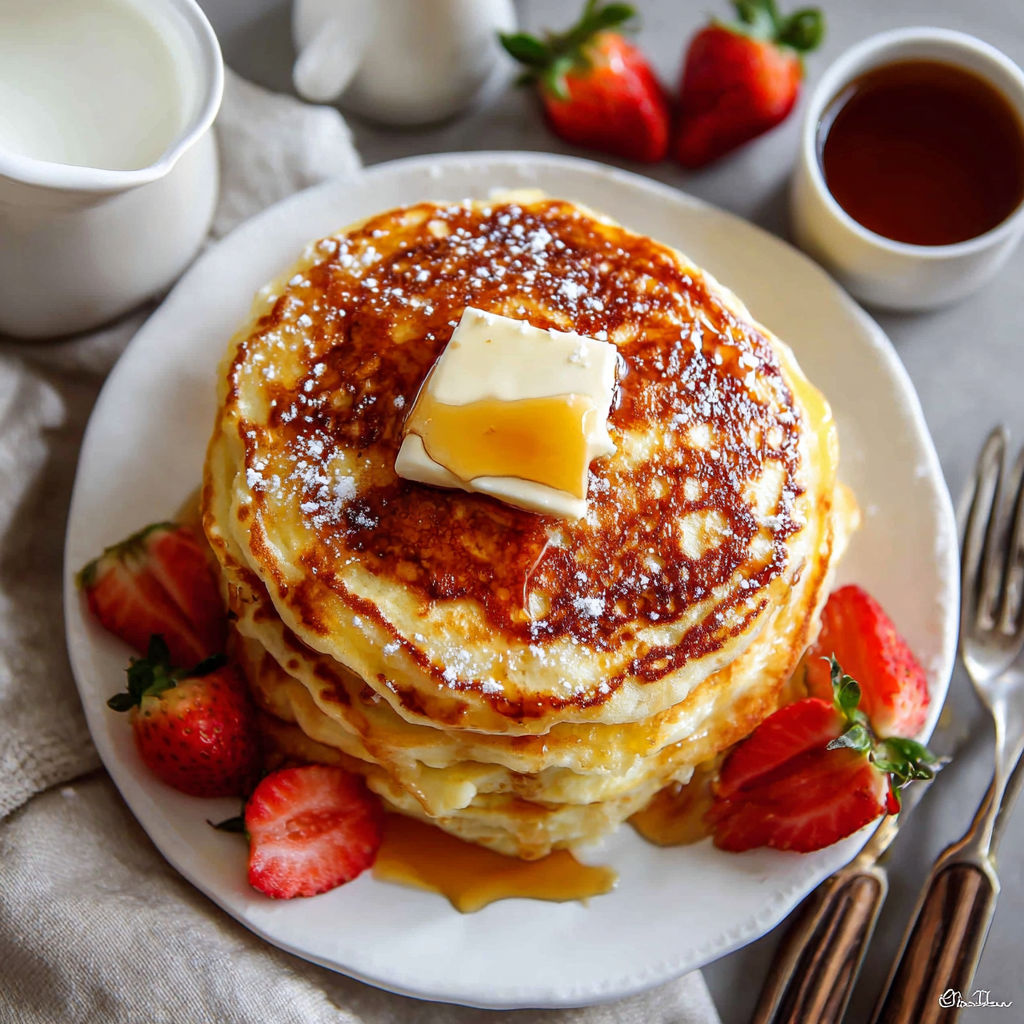 Pin
Pin
This buttermilk pancake recipe has been my holy grail breakfast search for years. Fluffy yet crispy on the edges, tender in the middle, and perfectly stackable. The balance of buttermilk tang with just enough sweetness makes these truly exceptional pancakes that have ruined restaurant versions for me forever.
I discovered this recipe during a weekend snowstorm when we couldn't leave for brunch. My family now refuses restaurant pancakes and requests these weekly, claiming nothing else compares to their perfect texture and flavor.
- Butter adds richness and helps create those irresistible crispy edges
- Real buttermilk is crucial for tenderness and tang do not substitute with milk and vinegar if possible
- Separated eggs with whites folded in separately creates extraordinary fluffiness
- Bacon grease for cooking adds flavor depth that butter alone cannot match
- Baking soda and powder in perfect ratio creates the ideal rise without metallic aftertaste
How To Make Best Buttermilk Pancakes
- Prep Your Space
- Warm your oven to 170°F and gather three mixing bowls large medium and small. This preparation ensures your pancakes stay warm while cooking batches and organizes your workflow efficiently.
- Melt The Butter
- Melt your butter in the large bowl and set aside to cool slightly. Melted but not hot butter incorporates better without cooking eggs prematurely when added.
- Mix Dry Ingredients
- In the medium bowl whisk together flour sugar salt baking soda and baking powder until evenly distributed. This prevents pockets of baking soda that could create bitter bites.
- Prepare Wet Ingredients
- Add buttermilk and milk to the cooled melted butter. Separate eggs adding whites to small bowl and yolks to the wet mixture. Whisk yolks into wet ingredients thoroughly.
- Beat Egg Whites
- Gently whisk egg whites for about 20 seconds until slightly foamy. This creates air pockets without fully whipping allowing easier incorporation while maintaining structure.
- Combine With Minimal Mixing
- Add wet ingredients to dry and stir minimally with wooden spoon. Stop while flour streaks remain visible to prevent gluten development which toughens pancakes.
- Fold In Whites
- Gently fold in the foamy egg whites leaving some visible streaks. This preserves air bubbles creating exceptional fluffiness during cooking.
- Cook To Perfection
- Heat griddle over medium heat then lightly grease with bacon grease. Pour batter using half cup measure and cook until bubbles form and pop on surface. Flip to cook other side until golden brown about 2 to 3 minutes.
- Keep Warm
- Transfer cooked pancakes to wire rack in warm oven which maintains texture without steaming. Continue with remaining batter maintaining consistent heat for even cooking.
The bacon grease for cooking these pancakes might seem old fashioned but it creates an incredible flavor foundation. My grandmother taught me this trick and watching my children devour these pancakes with the same enthusiasm she once saw in me creates a beautiful connection across generations.
Perfect Buttermilk Matters
Real cultured buttermilk makes a tremendous difference in this recipe. Its thickness and acidity create tenderness while contributing complex flavor. If you absolutely must substitute use whole milk or even half and half with vinegar or lemon juice for better results than skim milk versions. Allow this mixture to sit for 10 minutes before using to develop some thickness.

Storage and Reheating
These pancakes maintain their quality surprisingly well when properly stored. For next day enjoyment place cooled pancakes in an airtight container with parchment between layers to prevent sticking. Refrigerate up to three days. For longer storage freeze pancakes in a single layer on a baking sheet then transfer to freezer bags with parchment between each pancake. Reheat frozen pancakes in a toaster or 350°F oven for about 5 minutes until warmed through without becoming soggy.
Flavor Variations
While perfect on their own these pancakes become an amazing canvas for creativity. Fold in fresh blueberries or sliced banana just before cooking. Add a teaspoon of cinnamon or vanilla extract to the batter for warmth. For indulgent weekend brunch sprinkle chocolate chips or toasted nuts over the uncooked side before flipping. My family particularly loves them with diced apple and cinnamon in fall months.
Serving Suggestions
These pancakes shine with classic maple syrup and butter but deserve creative toppings too. Try homemade fruit compote fresh berries whipped cream or even a dollop of Greek yogurt with honey. For special occasions create a pancake bar with various toppings allowing everyone to customize their stack. I particularly love serving these with crispy bacon and scrambled eggs for a complete breakfast experience.

Recipe FAQs
- → Can I substitute real buttermilk in this pancake recipe?
While you technically can use a milk-vinegar mixture, it won't deliver the same results as real buttermilk. The thickness of genuine buttermilk is key to these pancakes' texture. If you must substitute, use the highest fat milk possible (whole milk or half-and-half) with 1.5 tablespoons of vinegar or lemon juice per 2 cups.
- → Why do some people taste baking soda in these pancakes?
Some sensitive palates may detect baking soda. If concerned, reduce to 1¾ teaspoons each of baking soda and baking powder. When doubling the recipe, use 3½ teaspoons of each instead of 4 teaspoons to prevent any metallic taste.
- → What's the key to getting fluffy pancakes with crispy edges?
The combination of separated eggs (with whites lightly beaten), minimal mixing of the batter (leaving flour streaks), and cooking on a properly heated surface with bacon grease creates the ideal texture contrast between crispy exterior and fluffy interior.
- → How do I know when to flip the pancakes?
Look for bubbles forming on the surface that begin to pop, and the edges starting to set. The underside should be golden brown. After flipping, cook for another 2-3 minutes until both sides have that perfect golden color.
- → Why should I place cooked pancakes on a rack in a warm oven?
This technique keeps your pancakes warm without making them soggy. The rack allows air circulation, preventing condensation from forming underneath, while the low oven temperature (170°F) maintains their warmth without continuing to cook them.
- → What makes these pancakes 'stackable'?
The specific ratio of ingredients and the thickness from real buttermilk creates pancakes with the perfect structure. They're substantial enough to hold their shape when stacked but remain tender when cut with a fork.
